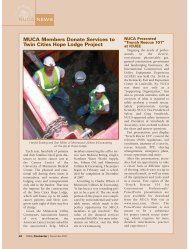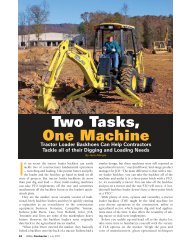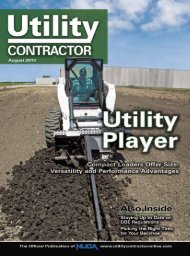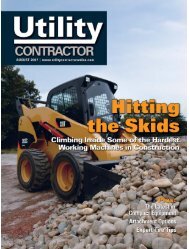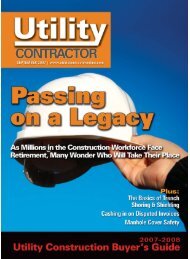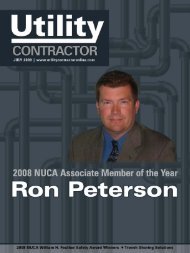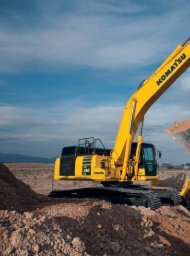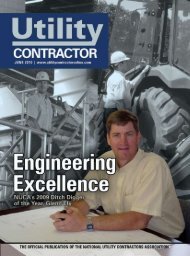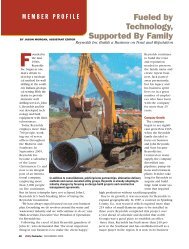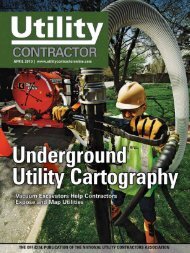View Full May PDF Issue - Utility Contractor Online
View Full May PDF Issue - Utility Contractor Online
View Full May PDF Issue - Utility Contractor Online
You also want an ePaper? Increase the reach of your titles
YUMPU automatically turns print PDFs into web optimized ePapers that Google loves.
SAFETY MANAGEMENT<br />
What You Need to Know<br />
about HEB Safety<br />
By George Kennedy<br />
Horizontal earth boring (HEB) is a trenchless method<br />
used to install a pipe or a pipe casing in which other<br />
utilities will eventually be inserted. The process involves<br />
simultaneously jacking a pipe or pipe casing through<br />
the earth while removing the spoil by means of a rotating auger.<br />
Although boring operations have been used for decades and are<br />
considered to be safe when performed properly, there are potential<br />
hazards that must be addressed before and during the process.<br />
<strong>Utility</strong> Damage Prevention<br />
Before proceeding with any type of trenchless method, all<br />
utilities crossing the center line of the bore or in the immediate<br />
vicinity of the bore should be identified. Dig Safe call centers<br />
should be notified at least 24 to 72 hours (check state One-Call<br />
laws) prior to starting work. After the utilities are identified, it is<br />
extremely important to determine the exact location and depth<br />
of utilities that cross the bore path. Damaging a gas, electric or<br />
water line can have serious consequences, including injuries to<br />
workers and/or the public. Call before you dig!<br />
Protective Systems<br />
HEB requires the excavation of boring and receiving pits.<br />
As with any excavation, precautions must be taken to ensure that<br />
they will not cave in and bury a workers. In brief, HEB contractors<br />
must comply with the same trenching and excavation<br />
rules as open-cut contractors. OSHA and state regulations require<br />
that protective systems be installed in the form of shoring,<br />
trench boxes or sloping. They must be properly installed and<br />
maintained. Additionally, there must be a Competent Person on<br />
the job, and that person must ensure that the job remains safe as<br />
it progresses by means of daily and as-needed inspections.<br />
Fall Protection<br />
Before a pit is dug, consideration should be given to ensuring<br />
that no one will fall into it. Such a fall can result in serious<br />
injuries, not only from the fall itself, but also from landing on<br />
machinery, tools and/or materials that will eventually be in the<br />
pit. Since OSHA Subpart M is not specific with regard to HEB<br />
operations, contractors have some options.<br />
It has, for example, been suggested that all pits should be<br />
surrounded by a fence or barricades to keep unauthorized<br />
108 <strong>Utility</strong> <strong>Contractor</strong> | <strong>May</strong> 2009<br />
people away from excavation. If the pit is over 6 ft deep, some<br />
form of fall protection system must be put in place to ensure<br />
worker safety. The most reliable form of fall protection<br />
is a guard rail system that surrounds the edge. Whether constructed<br />
of wood, steel pipe, cables or other material, the system<br />
must be able to support 200 lbs in an inward/downward<br />
direction. The top rail or cable would have to be 42 in. ± 3 in.<br />
above the ground with a midrail or barricade approximately<br />
half way up. Cable systems should not deflect more than 3 in.<br />
at any point.<br />
A controlled access zone (CAZ) — an area where certain work<br />
can take place without the use of a guardrail system — is another<br />
option. However, before establishing a CAZ the contractor<br />
must be able to demonstrate that it is infeasible or it creates<br />
a greater hazard to use conventional fall protection equipment<br />
such as guardrails, personal fall arrest system or motion stopping<br />
system. The CAZ plan will have to be created by a qualified<br />
person and supervised by Competent Persons who are<br />
trained and knowledgeable about fall protection. Individuals<br />
who are authorized to enter the CAZ must be identified in the<br />
written plan, which should be jobsite-specific and available at<br />
the jobsite.<br />
Once a CAZ has been set up it must be surrounded by a<br />
control line not less than 6 ft or more than 25 ft from the<br />
unprotected edge of the pit. Control lines must be adequately<br />
supported and flagged or otherwise clearly marked<br />
at not more than 6-ft intervals. If authorized workers are<br />
permitted inside the control lines, they must be trained<br />
and assigned a Competent Person (with no other duties<br />
to monitor).<br />
Hazardous Atmosphere<br />
The OSHA Excavation Standard–Subpart P states that<br />
“every excavation where a hazardous atmosphere exists or<br />
could reasonably be expected to exist” shall be tested and<br />
monitored with an air monitor to prevent employee exposure<br />
to a harmful atmosphere such as oxygen deficiency, explosive<br />
methane or hydrogen sulfide. Boring pits, especially deep<br />
ones, have the potential to contain a harmful atmosphere.<br />
To avoid worker exposure to a hazardous atmosphere created<br />
by these and other potential scenarios, it has been suggested




